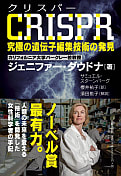
スウェーデンの王立科学アカデミーは7日、2020年のノーベル化学賞を、「ゲノム編集」の手法開発で成果を上げたマックス・プランク研究所のエマニュエル・シャルパンティエ氏とカリフォルニア大バークリー校のジェニファー・ダウドら仏米の2人に授与すると発表した。
遺伝子を改変するゲノム編集技術「CRISPR(クリスパー)/Cas9(キャスナイン)」。2人は細菌がウイルスから身を守る仕組みを解明し、ゲノム編集技術として応用できることを示した。
授賞式は新型コロナウイルスの流行を考慮し、オンラインで(とね日記賞の発表と同じ)12月10日に開かれる。賞金は1千万スウェーデンクローナ(約1億2千万円)で、受賞者で分ける。
The Nobel Prize in Chemistry 2020
https://www.nobelprize.org/prizes/chemistry/2020/summary/
Announcement of the Nobel Prize in Chemistry 2020
今年の化学賞は生化学分野で受賞が決まった。予想できた人はほとんどいなかったと思う。発表では次のようなスライドが映された。

拡大

拡大

拡大

拡大

拡大

拡大

発表のタイミングで公開されたプレスリリースを和訳したものを載せておこう。
プレスリリース(英語):
https://www.nobelprize.org/uploads/2020/10/press-chemistryprize2020.pdf
日本語訳:
2020年ノーベル物理学賞
“ゲノム編集方法の開発に対して”
”
エマニュエル・シャルパンティエ, born 1968 in Juvisy-sur-Orge, France. Ph.D. 1995 from Institut Pasteur, Paris, France. Director of the Max Planck Unit for the Science of Pathogens, Berlin, Germany. Max Planck Unit for the Science of Pathogens, Berlin, Germany.
ジェニファー・ダウドナ, born 1964 in Washington, D.C, USA. Ph.D. 1989 from Harvard Medical School, Boston, USA. Professor at the University of California, Berkeley, USA and Investigator, Howard Hughes Medical Institute.
遺伝子ハサミ:生命のコードを書き直すためのツール.
エマニュエル・シャルパンティエとジェニファー・ダウドナは、遺伝子技術の最も鋭いツールの1つであるCRISPR / Cas9遺伝子ハサミを発見しました。これらを利用して、研究者は動物、植物、微生物のDNAを非常に高い精度で変更することができます。この技術はライフサイエンスに革命的な影響を与え、新しい癌治療に貢献しており、遺伝性疾患を治療するという夢を実現する可能性をもっています。
研究者は、生命の内部の働きを知るために、細胞内の遺伝子を改変する必要があります。これは時間がかかり、困難で、時には不可能な作業でした。CRISPR/Cas9遺伝子ハサミを使用して、数週間の間に生命のコードを変更することが可能になりました。
「この遺伝子ツールには非常に大きな力があり、それが私たち全員に影響を及ぼします。それは基礎科学に革命をもたらしただけでなく、革新的な収穫をもたらし、画期的な新しい医療につながるでしょう」とノーベル化学委員会の議長であるクラース・グスタフソンは述べています。
科学ではよくあることですが、これらの遺伝子ハサミの発見は予想外でした。エマニュエル・シャルパンティエが人類に最も害を及ぼす細菌の1つである化膿レンサ球菌を研究しているときに、彼女はこれまで知られていなかった分子であるtracrRNAを発見しました。彼女の研究は、tracrRNAが細菌の古代の免疫システムであるCRISPR / Casの一部であり、DNAを切断することによってウイルスを武装解除することを示しました。
シャルパンティエは2011年に彼女の発見を発表しました。同じ年、彼女はRNAの幅広い知識を持つ経験豊富な生化学者であるジェニファー・ダウドナとの共同研究を開始しました。一緒になって、彼らは試験管内でバクテリアの遺伝子ハサミを再現し、ハサミの分子成分を単純化して使いやすくすることに成功しました。
画期的な実験で、彼らは遺伝子ハサミを再プログラムしました。ハサミは自然な形でウイルスからのDNAを認識しますが、シャルパンティエとダウドナは、所定の部位で任意のDNA分子を切断できるように制御できることを証明しました。DNAが切断された場所では、生命のコードを簡単に書き直すことができます。
シャルパンティエとダウドナが2012年にCRISPR/Cas9遺伝子ハサミを発見して以来、その使用は爆発的に増加しました。このツールは、基礎研究における多くの重要な発見に貢献しており、植物研究者は、カビ、害虫、干ばつに耐える作物を開発することができました。医学では、新しいがん治療法の臨床試験が進行中であり、遺伝性疾患を治療できるという夢が実現しようとしています。これらの遺伝子ハサミは、生命科学を新しい時代に導き、多くの点で人類に最大の利益をもたらしています。
イラスト
以下のイラストは非商用目的である限り無料で使用できます。著作権はスウェーデン王立科学アカデミー、Johan Jamestadに帰属します。
イラスト: Using the genetic scissors (pdf)
イラスト: Streptococcus’ natural immune system against viruses:CRISPR/Cas9 pdf)
イラスト: CRISPR/Cas9 genetic scissors (pdf)
今年の賞の関連文献
関連情報: Genetic scissors: a tool for rewriting the code of life (pdf)
科学的背景: A tool for genome editing (pdf)
シャルパンティエ博士、ダウドナ博士、化学賞受賞おめでとうございます。
受賞後の電話インタビュー再生: シャルパンティエ博士 ダウドナ博士
感想、コメント:
今年は昨日発表された物理学賞だけでなく、化学賞も予想外の授賞となった。対象が化学というより生化学、分子生物学の研究になったからだ。どちらかというと医学・生理学賞として授賞するのがこれまでの慣例だと思う。
そして受賞したのがこれまでの受賞者とくらべ、比較的若い女性研究者であることも注目に値する。年齢や性別で差別をしないのが世界の常識ではあるが、長年にわたって研究を続け、ノーベル賞に値する業績を積むという必要性を考えれば、高齢の男性研究者が受賞しやすくなるというのが一般的な認識だと思うからだ。
数年前にDNAについての本を3冊読んだだけで、僕はほとんど詳しくない領域だ。ゲノム編集は将来、私たちの生活にかかわってくる技術であるだけに、ひととおりの知識を得ておきたいと思った。
関連動画:
今回受賞された2人の先生方の動画を紹介しておこう。
2020 Nobel Lectures in Chemistry
3rd Kyoto Prize Symposium [Biotechnology and Medical Technology] Emmanuelle Charpentier
シャルパンティエ博士の動画: YouTubeで検索
Re-writing the Code of Life: CRISPR Systems and Applications of Gene Editing
ダウドナ博士の動画: YouTubeで検索
シャルパンティエ博士とダウドナ博士による講演動画
2017 Japan Prize Commemorative Lecture: Prof. Emmanuelle Charpentier & Dr. Jennifer A. Doudna
関連書籍:
「CRISPR 究極の遺伝子編集技術の発見」は、今回受賞したダウドナ博士の著書なので、超お勧めだ。あと、講談社ブルーバックスの本も紹介しておこう。
「CRISPR 究極の遺伝子編集技術の発見: ジェニファー・ダウドナ」(Kindle版)(原書)(原書Kindle版)
「ゲノム編集とはなにか 「DNAのハサミ」クリスパーで生命科学はどう変わるのか」(Kindle版)


より専門的に学びたい方は、次の2冊をチェックしてほしい。
「ゲノム編集の基本原理と応用: ZFN,TALEN,CRISPR-Cas9」(Kindle版)
「完全版 ゲノム編集実験スタンダード〜CRISPR-Cas9の設計・作製と各生物種でのプロトコールを徹底解説 」(Kindle版)


関連記事:
二重螺旋 完全版: ジェームズ・D. ワトソン
https://blog.goo.ne.jp/ktonegaw/e/cdba27cd80ae2ec99652d25e7fccdf26
DNA (上)―二重らせんの発見からヒトゲノム計画まで: ジェームズ・D. ワトソン
https://blog.goo.ne.jp/ktonegaw/e/2ce183a88058ccd08d6cb1265a835405
DNA (下)―ゲノム解読から遺伝病、人類の進化まで: ジェームズ・D. ワトソン
https://blog.goo.ne.jp/ktonegaw/e/f010fe8bb444188c8229eb25876d543f
メルマガを書いています。(目次一覧)

応援クリックをお願いします。




英語原文:
“for the development of a method for genome editing”
The Nobel Prize in Chemistry 2020
Emmanuelle Charpentier, born 1968 in Juvisy-sur-Orge, France. Ph.D. 1995 from Institut Pasteur, Paris, France. Director of the Max Planck Unit for the Science of Pathogens, Berlin, Germany. Max Planck Unit for the Science of Pathogens, Berlin, Germany
Jennifer A. Doudna, born 1964 in Washington, D.C, USA. Ph.D. 1989 from Harvard Medical School, Boston, USA. Professor at the University of California, Berkeley, USA and Investigator, Howard Hughes Medical Institute.
Genetic scissors: a tool for rewriting the code of life
mmanuelle Charpentier and Jennifer A. Doudna have discovered one of gene technology’s sharpest tools: the CRISPR/Cas9 genetic scissors. Using these, researchers can change the DNA of animals, plants and microorganisms with extremely high precision. This technology has had a revolutionary impact on the life sciences, is contributing to new cancer therapies and may make the dream of curing inherited diseases come true.
Researchers need to modify genes in cells if they are to find out about life’s inner workings. This used to be time-consuming, difficult and sometimes impossible work. Using the CRISPR/Cas9 genetic scissors, it is now possible to change the code of life over the course of a few weeks.
“There is enormous power in this genetic tool, which affects us all. It has not only revolutionised basic science, but also resulted in innovative crops and will lead to ground-breaking new medical treatments,” says Claes Gustafsson, chair of the Nobel Committee for Chemistry.
As so often in science, the discovery of these genetic scissors was unexpected. During Emmanuelle Charpentier’s studies of Streptococcus pyogenes, one of the bacteria that cause the most harm to humanity, she discovered a previously unknown molecule, tracrRNA. Her work showed that tracrRNA is part of bacteria’s ancient immune system, CRISPR/Cas, that disarms viruses by cleaving their DNA.
Charpentier published her discovery in 2011. The same year, she initiated a collaboration with Jennifer Doudna, an experienced biochemist with vast knowledge of RNA. Together, they succeeded in recreating the bacteria’s genetic scissors in a test tube and simplifying the scissors’ molecular components so they were easier to use.
In an epoch-making experiment, they then reprogrammed the genetic scissors. In their natural form, the scissors recognise DNA from viruses, but Charpentier and Doudna proved that they could be controlled so that they can cut any DNA molecule at a predetermined site. Where the DNA is cut it is then easy to rewrite the code of life.
Since Charpentier and Doudna discovered the CRISPR/Cas9 genetic scissors in 2012 their use has exploded. This tool has contributed to many important discoveries in basic research, and plant researchers have been able to develop crops that withstand mould, pests and drought. In medicine, clinical trials of new cancer therapies are underway, and the dream of being able to cure inherited diseases is about to come true. These genetic scissors have taken the life sciences into a new epoch and, in many ways, are bringing the greatest benefit to humankind.
Illustrations
The illustrations are free to use for non-commercial purposes. Attribute ”© Johan Jarnestad/The Royal Swedish Academy of Sciences”.
Illustration: Using the genetic scissors (pdf)
Illustration: Streptococcus’ natural immune system against viruses:CRISPR/Cas9 pdf)
Illustration: CRISPR/Cas9 genetic scissors (pdf)
Read more about this year’s prize
Popular information: Genetic scissors: a tool for rewriting the code of life (pdf)
Scientific Background: A tool for genome editing (pdf)






















